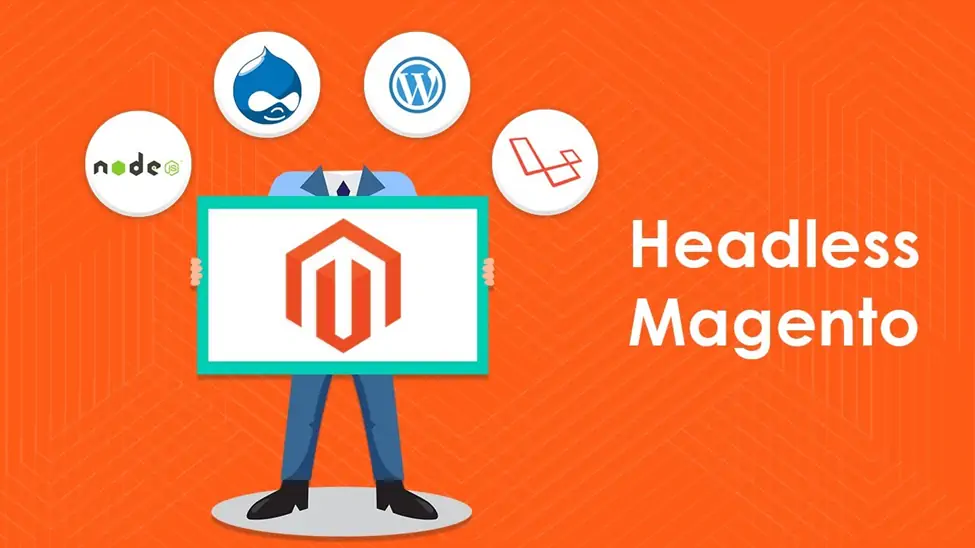Headless Magento has been pretty much in talks over the past few years. In case, if you have recently jumped in the Magento bandwagon; might find it new and hard to grasp, fret not because I am here to the rescue! The following post talks about what is headless Magento, its benefits, and how can you speed up your Magento 2 store. Basically, it sums up a little bit in the details of what and how.

The term headless is something you might have encountered before; remember the automated browser tests. The time where you script the actions a browser would take to. Let's say, for example; you wish to add a product to a cart. Now let us delve into the details of what headless eCommerce architecture actually is? It basically refers to a CMS which stores, manages and delivers content even in the absence of a frontend delivery layer. Imagine it more like ahead of the store which is decoupled leaving only the body; i.e., the backend. Magento developers make use of APIs to deliver elements such as products, customer reviews, or blog posts to any device or screen. At the same time, frontend developers can invest their time and energy on presenting the content using a framework of their choice.
It may quite interest you to know that in earlier days, e-commerce platforms featured a head screwed on tight. Technically speaking, the frontend was tightly coupled with the backend in these platforms. Furthermore, even if the platform offered some unrestricted access to code. As a result, content would be delivered in conventional forms, namely websites and native mobile apps. With the emergence of headless architecture, brands now are able to deliver products, content, and payment gateways to kiosk screens, Alexa skills, smartwatches, and everything in between. And trust me, this is just the beginning!
What makes headless e-commerce a cut above?
- Omnichannel capabilities- In the earlier days, sales used to be relatively simple because they were confined to the desktop only, but as soon as the eCommerce came into limelight for the very first time, things changed. Front-end and back-end coupled together, buying channels became multivariate in nature and what not! In the present scenario, businesses require dealing with a complex matrix of buyer touchpoints, and omnichannel platform has become the way of selling online. However, aligning with the omnichannel approach, things are easier said than done because it demands flexibility, which full-stack solutions can seldom execute. With the increasing close bond between frontend and backend, things became impossible to change one without touching the other. And now with headless eCommerce, we get an adequate amount of flexibility required in this context.
- Easy integration- Numerous brands which previously used their sites as content repositories now aim to explore the myriad opportunities that the eCommerce domain offers. Well, I am certainly not saying that they would lose a massive amount of content which already exists. When it comes to implementation, it will be way feasible to build an eCommerce engine and connect it with the existing CMS instead of creating a new store and migrating the existing content into it. The headless architecture comes ahead as a great solution as it enables quicker and easier integration for such websites. This makes entry into the e-commerce space much easier for the existing businesses.
Why go headless with Magento?
I hope till now we have our definitions straight. Time to get into why the headless path is better than traditional e-commerce routes:
1. Customization and flexibility to a great extent
You can create custom experiences to match your brand; well, I am not talking about the generic or template-ish ones. Many of you have this misconception that it is impossible to customize your Shopify/Magento/BigCommerce store. Absolutely not. But you won't ever get the same freedom to build thoughtful UX as with modern frontend frameworks.
2. Portable backends, data, and data structure
Gone are the days when Magento developers used to be dependent on massive, restricting infrastructures. With headless, you can stay competitive with your frontend, without being locked inside turnkey or coupled solutions.
3. Better multi-platform shopping experience
Mobile, desktop apps, IoT, web, you name it, and you have it! By using headless CMS, you can pick the best frontend tooling for every platform/device. Adapting and scaling your business is much easier when your backend can output whatever you want, wherever you want.
4. Develop with the JAMstack
Do you really think that faster, more secure, and cheaper websites & apps are the main promises of the JAMstack? Well, in actual sense, the JAMstack's sexiest promise is this: a conscious, creative, and strategic development experience for modern developers.
In a nutshell
After understanding the aforementioned pointers, it becomes very clear that headless Magento can make your online store go places. So why not give it a try!









